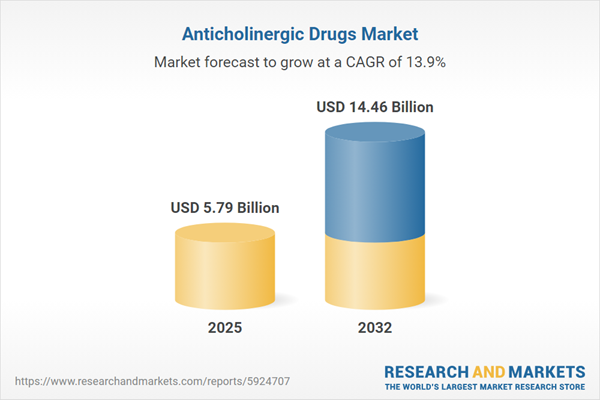Speak directly to the analyst to clarify any post sales queries you may have.
The anticholinergic drugs market is undergoing rapid transformation, shaped by evolving regulations and accelerated digital adoption. Senior decision-makers are prioritizing strategic market intelligence to overcome supply challenges, boost operational efficiency, and identify opportunities for sustainable growth.
Market Snapshot: Anticholinergic Drugs Market Overview
In 2024, the anticholinergic drugs market is valued at USD 5.09 billion, projected to increase to USD 5.79 billion by 2025 and reach USD 14.46 billion by 2032. Growth is supported by advancements in drug delivery systems and the focused management of therapies for chronic conditions. Organizations are investing in digital health initiatives to enhance patient outcomes and streamline healthcare operations. Intensifying competition and changing regulatory guidelines are encouraging the adoption of agile business models, enabling continuous innovation while prioritizing compliance and workflow optimization. The direction of industry development now relies heavily on digital transformation and regulatory adaptation.
Scope & Segmentation: Deep Dive into Anticholinergic Therapeutics
- Indication: Chronic obstructive pulmonary disease, gastrointestinal disorders, overactive bladder, and Parkinson’s disease drive targeted drug development and maintain relevance in clinical care pathways.
- Route of Administration: Inhalation, oral, parenteral, topical, and transdermal methods expand patient access and align with diverse care settings and provider workflows.
- Distribution Channel: Distribution spans hospitals, retail pharmacies, and online platforms, enabling consistent product availability and adaptability to emerging market preferences.
- Product Type: The product range includes natural compounds such as atropine and hyoscyamine, alongside synthetic derivatives like quaternary ammonium and tertiary amines, all supporting innovation and therapeutic differentiation.
- Regional Coverage: North America, South America, Europe, Middle East and Africa, and Asia-Pacific each present unique compliance requirements and reimbursement landscapes, making region-focused market entry strategies essential for success.
- Companies Profiled: Prominent participants include Boehringer Ingelheim International GmbH, GlaxoSmithKline plc, AstraZeneca plc, Novartis AG, Astellas Pharma Inc., Pfizer Inc., Johnson & Johnson, Teva Pharmaceutical Industries Ltd., Viatris Inc., and Sandoz International GmbH.
Key Takeaways: Strategic Insights for Decision-Makers
- Continuous innovation in extended-release and transdermal formulations strengthens treatment adherence, supporting improved engagement for both patients and providers across care environments.
- Precision in receptor-targeted therapy development allows clinical teams to optimize treatment matching, addressing evolving and unmet patient needs effectively.
- Collaboration between academia and industry accelerates development cycles, enabling faster introduction of new therapies for various indications and strengthening the innovation pipeline.
- Digital health tools are being integrated to improve patient compliance, operational oversight, and foster tighter collaboration among payers, providers, and other stakeholders.
- Procurement and reimbursement structures continue to shift, building resilience and agility required to adapt to regulatory updates and intensifying competition.
- Focused supply chain risk management practices help ensure product continuity, reducing exposure to future supply disruptions in a volatile environment.
Tariff Impact: Navigating Cost and Supply Chain Adaptations
Recent tariffs imposed on pharmaceutical raw materials by the United States have prompted manufacturers to remodel sourcing strategies. Companies are expanding domestic production and broadening supplier bases to protect inventories. These measures ensure a stable supply and help offset the risks posed by global supply chain shifts and geopolitical factors.
Methodology & Data Sources
The insights in this report are developed from expert interviews, literature reviews, regulatory analytics, and sales data analysis. This multi-source approach produces practical recommendations tailored for strategic leadership in the anticholinergic drugs market.
Why This Report Matters
- Provides actionable guidance to strengthen procurement and supply chain resilience as regulatory and market competition intensify.
- Supports investment in digital health and therapeutic innovation for organizations seeking to synchronize with modern patient management needs.
- Offers practical pathways to enhancing market access and fostering partnerships that underpin sustainable business expansion.
Conclusion
This analysis offers the strategic foundation executive teams need to update operational approaches, optimize performance, and secure a proactive position within the evolving anticholinergic drugs landscape.
Additional Product Information:
- Purchase of this report includes 1 year online access with quarterly updates.
- This report can be updated on request. Please contact our Customer Experience team using the Ask a Question widget on our website.
Table of Contents
3. Executive Summary
4. Market Overview
7. Cumulative Impact of Artificial Intelligence 2025
List of Figures
Companies Mentioned
The companies profiled in this Anticholinergic Drugs market report include:- Boehringer Ingelheim International GmbH
- GlaxoSmithKline PLC
- AstraZeneca PLC
- Novartis AG
- Astellas Pharma Inc.
- Pfizer Inc.
- Johnson & Johnson
- Teva Pharmaceutical Industries Ltd.
- Viatris Inc.
- Sandoz International GmbH
Table Information
| Report Attribute | Details |
|---|---|
| No. of Pages | 182 |
| Published | November 2025 |
| Forecast Period | 2025 - 2032 |
| Estimated Market Value ( USD | $ 5.79 Billion |
| Forecasted Market Value ( USD | $ 14.46 Billion |
| Compound Annual Growth Rate | 13.9% |
| Regions Covered | Global |
| No. of Companies Mentioned | 11 |









